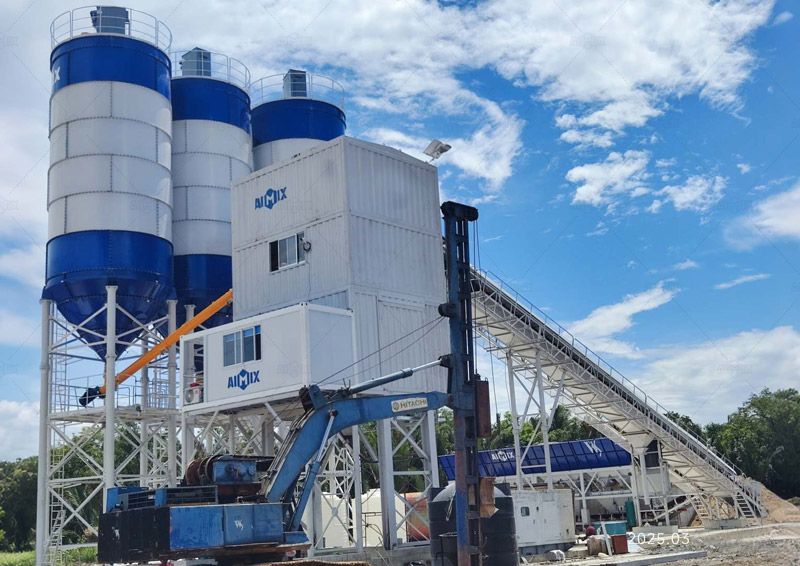The journey to acquiring a concrete batching plant is an exhilarating venture, yet the vast price disparities between manufacturers can be a source of significant confusion. One cannot simply compare the sticker price of concrete batching plant from a low-cost provider with that of an established global leader; the underlying value propositions are fundamentally different. These cost variations are not arbitrary but are deeply rooted in a trifecta of critical factors: the foundational engineering and component quality, the sophistication of the automation and control system, and the long-term financial implications encapsulated in the total cost of ownership. A discerning buyer looks beyond the initial capital expenditure to understand the intricate tapestry of design philosophy, operational efficiency, and lifecycle costs that truly define the investment’s value.

The Engineering Core: Deconstructing Build Quality and Component Provenance
At the heart of every batching plant lies its structural and mechanical DNA. This is the first and most substantial differentiator, where cost is directly correlated with durability, precision, and longevity.
Structural Integrity and Material Specifications
The divergence begins with the raw materials. A competitively priced plant may utilize standard-grade steel for its mixer frame, aggregate batcher, and support structures. In contrast, a premium manufacturer will often employ high-tensile, abrasion-resistant steel, with thicker plate sections at critical stress points. The engineering design itself involves sophisticated finite element analysis (FEA) to simulate decades of vibrational loads and dynamic stresses, ensuring structural resonance is mitigated. This results in a plant that doesn’t just feel more robust; it possesses an inherent resilience that minimizes frame fatigue, misalignment, and the chronic maintenance issues that plague less rigorously engineered equipment. The silo, a component under immense pressure, exemplifies this—its stiffener rings, weld quality, and plate thickness are non-negotiable aspects of safe, long-term operation.
The “Guts” of the Operation: Pumps, Motors, and Control Systems
The quality of core components is a monumental cost driver. The choice between standard industrial-grade hydraulic pumps and motors versus proprietary, high-efficiency units designed for continuous duty cycles has a direct impact on both price and performance. Premium manufacturers integrate components from top-tier suppliers like Siemens, Bosch Rexroth, or SEW-Eurodrive, ensuring exceptional reliability and energy efficiency. The pneumatic systems for gate actuation and the precision of load cells and weighing sensors further separate the tiers. A low-cost concrete batch plant for sale might function, but a high-integrity plant will deliver unwavering batching accuracy and repeatability, batch after batch, year after year, protecting your profit margin from material giveaway and ensuring consistent concrete quality.

The Automation Spectrum: How Control Systems Dictate Price Tiers
The control system is the brain of the batching plant, and its level of intelligence represents one of the most visible and impactful cost differentiators. This is where operational simplicity and advanced capability are forged.
From Basic Relay Logic to Sophisticated PLCs with SCADA
The most fundamental systems rely on relay-based logic or simple micro-processors, offering basic start/stop functionality with manual recipe input. The next echelon utilizes Programmable Logic Controllers (PLCs), which provide vastly superior reliability, troubleshooting capabilities, and automation of complex sequences. At the pinnacle are systems integrated with Supervisory Control and Data Acquisition (SCADA) software. These offer a graphical user interface that provides a holistic view of the entire concrete ready mix plant‘s operation, from aggregate bin levels to cement silo inventory, all from a centralized touchscreen or remote office. The programming complexity, hardware redundancy, and software licensing for these advanced systems contribute significantly to their cost but unlock unparalleled control and diagnostic power.
Precision Batching and Data Analytics Capabilities
Beyond basic control, the software’s capabilities directly influence profitability. Advanced systems feature automatic moisture compensation probes that adjust water content in real-time for flawless slump consistency. They maintain exhaustive databases of hundreds of mix designs and production reports, enabling traceability for every truck that leaves the plant. Some systems now incorporate predictive analytics, monitoring component performance to flag potential failures before they cause downtime. This level of precision and data intelligence minimizes human error, optimizes material usage, and provides invaluable business insights, creating a rapid return on the initial investment in a superior control platform.
The Total Cost of Ownership Equation: Beyond the Initial Price Tag
The most astute financial analysis of a batching plant extends over its entire operational lifespan. The initial purchase price is merely the entry fee; the true cost is revealed through years of operation and maintenance.
Operational Efficiency: Fuel, Power, and Maintenance Labor
A plant built with energy efficiency as a core principle will have a higher initial cost but a dramatically lower operating expense. This includes high-efficiency electric motors with variable frequency drives (VFDs) that reduce power consumption, well-sealed hydraulic systems that minimize leaks and heat generation, and optimized mixer designs that require less power to achieve a homogenous mix. Furthermore, designs that prioritize maintenance accessibility—with wide platforms, easy-to-reach grease points, and modular components—can cut labor hours for routine servicing in half. These design efficiencies compound over time, saving thousands in electricity and labor costs, swiftly closing the gap with a cheaper, less efficient alternative.
Parts Availability, Technical Support, and Residual Value
Perhaps the most critical long-term consideration is the manufacturer’s support ecosystem. A low initial price is a hollow victory if a single broken proprietary part halts production for weeks. Premium manufacturers maintain extensive global parts networks and offer 24/7 technical support, ensuring maximum uptime. They provide comprehensive documentation, training, and engineering support. Finally, the residual value of the plant must be considered. A well-known, respected brand with a reputation for durability will command a high resale value a decade later, while an obscure, low-cost model may have negligible worth. This robust support and enduring value complete the total cost of ownership picture, proving that the true cost of concrete batching plant is not what you pay for it, but what it costs you to own and operate it over its full productive life. Investing in quality engineering and support is ultimately the most enthusiastic and profitable decision a business can make.